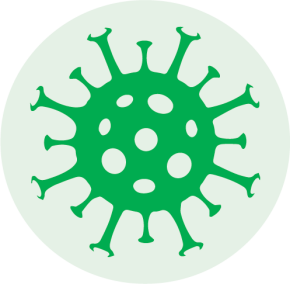

EDCTP portfolio: Emerging diseases
index


The Covid-19 HCW project is monitoring a cohort of healthcare workers to identify risk factors for infection, as well as to provide a clearer picture of the dynamics of immune responses to SARS-CoV-2.
Protecting healthcare workers against COVID-19

Healthcare workers are exposed on a daily basis to COVID-19 infections, and are at high risk of becoming infected. Preventing infection in health workers is important not just for their own health but also to limit the spread of COVID-19 in healthcare facilities and to ensure the availability of health care staff.
Although antibody responses are protective, it is unclear precisely which specific types of response elicited by the virus are most effective and, conversely, which contribute to severe disease symptoms. Generation of long-term ‘memory cells’, re-activated when the virus is re-encountered, is also not well understood.
The challenge

The Covid-19 HCW project is monitoring a cohort of healthcare workers exposed to COVID-19 patients at the Chris Hani Baragwanath Academic Hospital in South Africa, Africa’s largest tertiary hospital, which serves the township of Soweto and the surrounding area.
Healthcare workers will be monitored for COVID-19-like symptoms and tested regularly to detect symptomatic and asymptomatic infections, and data will be collected on their health, demographics and working practices. The project aims to identify risk factors for infection, and for severe outcomes in those who are infected, in order to identify ways to prevent further infection. It will also test whether analysis of more convenient saliva samples can be used instead of discomforting nasal swabs.
In addition, the project will systematically analyse blood samples from all participants to monitor for the appearance of antibodies and to assess associations with severity of disease in those who become infected.
Finally, sophisticated cell sorting technology will be used to characterise multiple lymphocyte populations, to determine whether infections are associated with the appearance of memory cells that would protect against re-infection. This analysis will also shed light on cell-mediated (T-cell-based) responses to SARS-CoV-2.
The project

An understanding of infection status in healthcare staff will have several benefits. As well as identifying risk factors that can be targeted to improve infection control, testing will reveal whether healthcare workers need to quarantine, reducing the risk that asymptomatic carers pass on infections and providing psychological reassurance to healthcare staff. It will also enable those without infection to continue working. The impact on understanding the severity and history of infection will have broader implications to the overall population beyond the HCW community.
The project will also generate important data on the evolution of antibody-based and cell-mediated immunity in infected staff during acute phases of illness and convalescence. This will provide insights of general importance but may also reveal key differences specific to a sub-Saharan African setting.
Impact


“
test the safety and efficacy of this new formulation in young children
”
Bringing antiretroviral drugs to children

The CHAPAS trials have ensured that many more children with HIV have benefited
from life-saving antiretrovirals.
EDCTP portfolio: HIV & HIV-associated infections
The challenge
Healthcare workers are exposed on a daily basis to COVID-19 infections, and are at high risk of becoming infected. Preventing infection in health workers is important not just for their own health but also to limit the spread of COVID-19 in healthcare facilities and to ensure the availability of health care staff.
Although antibody responses are protective, it is unclear precisely which specific types of response elicited by the virus are most effective and, conversely, which contribute to severe disease symptoms. Generation of long-term ‘memory cells’, re-activated when the virus is re-encountered, is also not well understood.

The Covid-19 HCW project is monitoring a cohort of healthcare workers exposed to COVID-19 patients at the Chris Hani Baragwanath Academic Hospital in South Africa, Africa’s largest tertiary hospital, which serves the township of Soweto and the surrounding area.
Healthcare workers will be monitored for COVID-19-like symptoms and tested regularly to detect symptomatic and asymptomatic infections, and data will be collected on their health, demographics and working practices. The project aims to identify risk factors for infection, and for severe outcomes in those who are infected, in order to identify ways to prevent further infection. It will also test whether analysis of more convenient saliva samples can be used instead of discomforting nasal swabs.
In addition, the project will systematically analyse blood samples from all participants to monitor for the appearance of antibodies and to assess associations with severity of disease in those who become infected.
Finally, sophisticated cell sorting technology will be used to characterise multiple lymphocyte populations, to determine whether infections are associated with the appearance of memory cells that would protect against re-infection. This analysis will also shed light on cell-mediated (T-cell-based) responses to SARS-CoV-2.
The project
The later CHAPAS-3 trial compared the efficacy and safety of three fixed-dose combinations including two without stavudine (found to have some long-term side effects in adults, leading to a recommendation that its use be discontinued in children). The trial the first of its kind in Africa studied nearly 500 children at four sites in two African countries.
An understanding of infection status in healthcare staff will have several benefits. As well as identifying risk factors that can be targeted to improve infection control, testing will reveal whether healthcare workers need to quarantine, reducing the risk that asymptomatic carers pass on infections and providing psychological reassurance to healthcare staff. It will also enable those without infection to continue working. The impact on understanding the severity and history of infection will have broader implications to the overall population beyond the HCW community.
The project will also generate important data on the evolution of antibody-based and cell-mediated immunity in infected staff during acute phases of illness and convalescence. This will provide insights of general importance but may also reveal key differences specific to a sub-Saharan African setting.
ratios forfixed-dose combinations and on appropriatedosage according to weight.
The CHAPAS-3 trial confirmed the effectiveness of fixed-dose combinations, providing further impetus to the rollout of antiretrovirals to children. Its evidence on abacavir informed the WHO recommendation of abacavir-containing combinations for first-line therapy in children. Trial data have also been used to support applications for regulatory approval for new scored efavirenz tablets.
Impact
L’homme RF et al. Nevirapine, stavudine and lamivudine pharmacokinetics in African children on paediatric fixed-dose combination tablets. AIDS. 2008;22(5):557–65.
Mulenga V et al. Abacavir, zidovudine, or stavudine as paediatric tablets for African HIVinfected children (CHAPAS-3): an open-label, parallel-group, randomised controlled trial. Lancet Infect Dis. 2016;16(2):169–79.
WHO. Guidelines on the use of antiretroviral drugs for treating and preventing HIV infection: recommendations for a public health approach. 2010.
WHO. Consolidated guidelines on the use of antiretroviral drugs
for treating and preventing
HIV infection: Recommendations for a public health approach
(second edition). 2016
Projects: Children with HIV in Africa Pharmacokinetics and Adherence of Simple Antiretroviral Regimens (CHAPAS): CHAPAS-1 and -3
Project lead: Professor Chifumbe Chintu, University Teaching Hospital, Zambia (CHAPAS-1); Dr Veronica Mulenga, University Teaching Hospital, Zambia (CHAPAS-3)
Target population(s): Children with HIV
Sample size: 71 (CHAPAS-1); 480 (CHAPAS-3)
Countries involved: Ireland, the Netherlands, the UK, the USA, Zambia (CHAPAS-1); Uganda, Zambia (CHAPAS-3)
Project duration: 2005–2009 (CHAPAS-1); 2010 –2011 (CHAPAS-3)
EDCTP funding: €1.2M (CHAPAS-1); €4.6M (CHAPAS-3)
Total project funding: €1.2M (CHAPAS-1); €5.0M